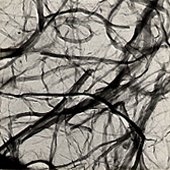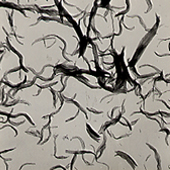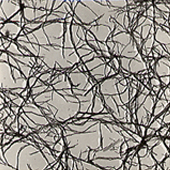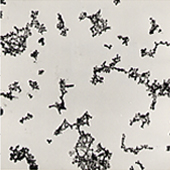Classification and Characteristics of Grease
Soap Grease
Calcium Soap Grease
In a typical manufacturing process of calcium soap grease, mineral oil, fatty acid, calcium hydroxide (hydrated lime) and water are mixed and cooked to bring to saponification. The process is complete after adjustment of water content. Grease made with tallow contains a small amount of water as structural stabilizer, and, when heated above 80°C, it loses its associated water, resulting in structure breakdown and separation of oil from thickener. Due to this poor heat resistance, it is used for general plain bearings operating under rather low speed and low load where temperature would not rise above 70°C in service. The water resistance is good on the other hand, and thus the grease performs well in applications exposed to water.
Use of caster oil fatty acid results in a grease which contains no water. Because the structure is stabilized without water, it can be used up to about 100°C.
Lithium Soap Grease
Lithium soap grease is the most widely used multi-purpose grease, from general industrial uses to automobiles, bearings and home electric products. It consists of mineral or synthetic oil and lithium stearate or lithium salt, a hardened fatty acid derived from castor oil. Usable in a wide range of temperature, and has excellent water resistance and mechanical stability.
Aluminum Complex Soap Grease
Aluminum complex grease is made from a complex soap which is formed by reaction of aromatic carboxylic acid and stearic acid on aluminum hydroxide. Aluminum complex grease is characterized by a very fine fiber structure, high dropping point (200°C or above) , excellent heat and water resistance and mechanical stability.
Lithium Complex Soap Grease
The soap is formed by reaction of lithium hydroxide with the mixture of fatty acid and dibasic acid. The dropping point of the finished grease is 250°C or higher. Lithium complex grease has excellent heat and water resistance and rust preventing property, as well as longer life at high temperature than lithium soap grease.
Non-Soap Greases
Urea Grease
Typical urea grease formulation uses organic compound containing more than two urea groups (-NH-CO-NH-) as thickening agent. Because of its excellent heat and water resistance, urea grease is an optimum choice for continuous casting lines and iron mills, and actually is the most widely used nonsoap grease.
Urea grease is also widely used for automotive electrical components. For high temperature condition, synthetic oil based urea grease is preferred.
Bentonite Grease
This grease thickened by organic bentonite is often called "grease without dropping point" or "grease without melting point," because it does not lose the grease structure even at extremely high temperature.
The grease can offer other advantages like good shear stability, but its application is limited because of rather poor rust prevention, hardening tendency when exposed to high temperature condition (200°C or above) for a long time, and poor ability to keep oil film on the bearing race surface during high speed rotation.
Other Non-Soap Greases
Other nonsoap greases include Na terephthalamate Grease, Copper Phthalocyanine Grease, Teflon (PTFE) Grease, Mica Grease and Silica Gel Grease.
Comparison of properties of grease due to thickener
Soap Thickener
| Thickener type | Maximum temperature limit | Water resistance | Shear Stability | Remarks | |
|---|---|---|---|---|---|
| Metalic soap | Calcium soap (stearate) | 70°C | F | F | Contains water (1%) as structural stabilizer. |
| Calcium soap (hydroxystearate) |
100°C | G | G | Contains no water. | |
| Aluminum soap | 80°C | G | P | Excellent adhesive characteristics. | |
| Sodium soap | 120°C | P | F | Emulsifies with water. | |
| Lithium soap (stearate) |
130°C | G | G | All-purpose with least weak points. | |
| Lithium soap (hydroxystearate) |
130°C | G | E | All-purpose with least weak points. | |
| Complex soap | Calcium complex | 150°C | G | G | Tends to harden by time and heat. |
| Aluminum complex | 150°C | E | E | Water-repellent type: good pumpability | |
| Lithium complex | 150°C | G | E | Lithium soap grease with better heat resistance. |
O: Outstanding E: Excellent G: Good F: Fair P: Poor
Non-Soap Thickener
| Thickener type | Maximum temperature limit | Water resistance | Shear Stability | Remarks | ||
|---|---|---|---|---|---|---|
| Urea | Diurea | Aromatic diurea | 180°C | O | O | Most stable urea; optimum for sealed application. |
| Aliphatic diurea | 180°C | E | E | All-purpose shear - softening type; optimum for centralized system. | ||
| Alicyclic diurea | 180°C | E | E | All-purpose but some tends to harden by shear. | ||
| Triurea | 180°C | G | F | Hardens by heat. | ||
| Tetraurea (Polyurea) | 180°C | G | F | Softens by shear; wide batch to batch variation. | ||
| Organic | Sodium terephthalamate | 180°C | G | G | High oil separation tendency, susceptible to oxidation due to its constituent metal group. | |
| PTFE | 250°C | O | O | Most stable but costly and requires high usage. | ||
| Inorganic | Organic bentonite | 200°C | F | G | Carbonized if used at high temperature for prolonged periods. | |
| Silica gel | 200°C | P | P | Susceptible to rusting in the presence of moisture. | ||
O: Outstanding E: Excellent G: Good F: Fair P: Poor
Electron Micrograph (x104) of Thickener Fiber Structure
Soap Thickener

(stearate)
Soap Thickener

(stearate)
Soap Thickener

(stearate)
Soap Thickener

(hydroxystearate)
Non-Soap Thickener

Non-Soap Thickener

Mineral oil based grease
Most of the greases used today are based on mineral oil.
Synthetic oil based grease
Synthetic oil grease is used for certain conditions where conventional mineral oil grease fails (in low-temperature property, heat resistance, low-torque property or longer life). Synthetic greases come in many different characteristics depending on the type of the oil used.
Ester oil based grease (diester, polyol ester, etc.)
Provides excellent lubricity; Usable over a wide temperature range from very low to very high; Tends to swell rubber.
Synthetic hydrocarbon oil based grease
Usable over a wide temperature range from very low to very high; Good rubber/plastic compatibility (because of the absence of polar group in the hydrocarbon molecular structure) except natural rubber and EPDM.
Polyethylene glycol oil based grease
Optimum for applications in contact with rubber because of little adverse effect on rubber including natural rubber and EPDM.
Phenyl ether oil based grease
Optimum for automotive electrical components for its excellent thermo-oxidative stability; Good radiation resistance.
Silicone oil based grease
Excellent thermo-oxidative stability and usable over a wide temperature range; Poor steel-on-steel lubricity.
Fluorinated oil based grease
Offers the best thermo-oxidative stability and high chemical resistance of all existing greases, but has the drawback of being very expensive. Optimal for chemical plants, high-temperature drying ovens and copying machine heat rollers.
Comparison of properties of grease due to base oil
| mineral oil | diester | polyol ester oil | hydrocarbon oil | polyethylene glycol oil | phenyl ether oil | silicone oil | fluorinated oil | ||
|---|---|---|---|---|---|---|---|---|---|
| Chemical structural formuls (typical) | mixed hydrocarbon | ||||||||
| Performance | Oil type | mid viscosity paraffinio | DOS | mid viscosity PET | mid viscosity PAQ | mid viscosity PPG | ADE | dimethyl silicone | mid viscosity PFAE |
| Lubricity (oiliness) | G | E | E | G | F | G | P | G | |
| Heat resistance | P | F | G | G | G | E | O | O | |
| Oxidative stability | P | F | G | G | F | E | O | O | |
| Low-temp. property | F | O | E | E | G | G | O | G | |
| Rubber compatibility | F | P | P | E | O | G | O | O | |
| Plastic compatibility | F | P | P | E | P | E | O | O | |
| Remarks | low cost | poor rubber compatibility | good rubber compatibility except natural rubber and EPDM | good rubber compatibility including natural rubber and EPDM | excellent radiation resistance | poor steel - on - steel boundary lubricity | best chemically stable of all existing greases; very costly | ||
O:Outstanding E:Excellent G:Good F:Fair P:Poor